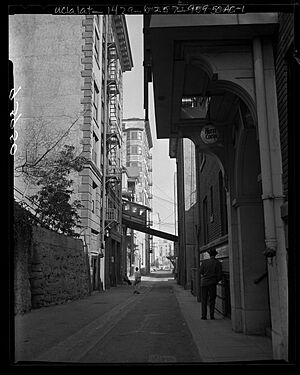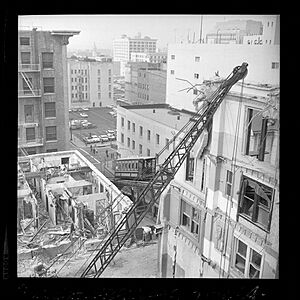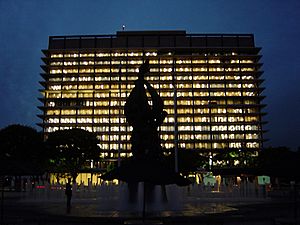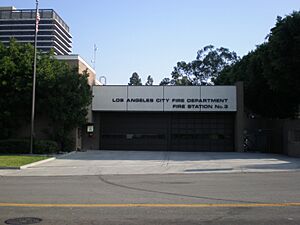Bunker Hill, Los Angeles facts for kids
Quick facts for kids
Bunker Hill
|
|
|---|---|
| Country | United States |
| State | California |
| County | Los Angeles |
| City | Los Angeles |
| Named for | Battle of Bunker Hill |
| Area code(s) | 213 |
Bunker Hill is a neighborhood in Los Angeles, California. It is part of Downtown Los Angeles.
Historically, Bunker Hill was a big hill that separated the old Victorian-era Downtown from the city's western side. Tunnels were dug through the hill at Second Street in 1924, and also at Third and Fourth Streets. Later, in the late 1900s, the hill was made lower. The whole area was rebuilt with modern tall buildings and other structures for homes, businesses, entertainment, and schools.
Contents
Bunker Hill's Story

How Bunker Hill Began
In 1867, two rich developers, Prudent Beaudry and Stephen Mott, bought most of the land on Bunker Hill. Beaudry's land was between Hill Street and Olive Street, and 4th Street and 2nd Street. Mott's land was between 4th Street and Temple, and Figueroa and Grand. Beaudry knew the hill had amazing views of the Los Angeles Basin and the Los Angeles River. He thought it would be a great place for fancy homes.
Beaudry started building his own house on top of the hill. He needed water pipes to reach the top. The Los Angeles Water Company first said no to his request. So, he built his own pipes and started the Canal and Reservoir Company. Several new streets were made. One of them, Bunker Hill Avenue, was named after the Battle of Bunker Hill. This street eventually gave the neighborhood its name.
Beaudry built grand, two-story Victorian houses on Bunker Hill. These homes became famous for Los Angeles's upper-class families. The houses were mostly in the Queen Anne and Eastlake styles. Living on the hill allowed these residents to escape the busy city below.
Some famous people who lived there included:
- Prudent Beaudry – He was the 13th Mayor of Los Angeles and helped develop Bunker Hill.
- L. J. Rose – A winemaker and business owner.
- Dr. Edmund Hildreth – A retired clergyman.
- D. F. Donigan – A self-made businessman who built the first railroad from Los Angeles to Pasadena.
- Lewis L. Bradbury, Sr. and his wife – They got rich from silver mines in Mexico. He owned the famous Bradbury Building in Downtown LA.
- Judge Robert M. Widney – He founded the University of Southern California. He also helped create the first transportation up the hill, a horse-drawn carriage.
After the horse carriage, the famous Angel's Flight railway was suggested. Angel's Flight, known as "The World's Shortest Railway," helped residents travel up and down the steep hill. Colonel J. W. Eddy asked the Los Angeles City Council to build an electric cable railway. The mayor, Meredith P. Snyder, approved it ten days later. The first railway opened on Third Street, from Hill Street to Olive Street.
Changes Over Time
Bunker Hill was a fancy residential area until after World War I. Around the 1920s and 1930s, with new electric railways and freeways, wealthy residents started moving to places like Beverly Hills and Pasadena. The large Victorian houses on Bunker Hill were divided into smaller apartments for renters.
By World War II, Bunker Hill became "Los Angeles's most crowded neighborhood." The Pasadena Freeway was built to bring shoppers downtown, but it also took more residents away. After the war, more freeways were built, leaving downtown with fewer people and services. The once-grand Victorian homes became cheap housing for people with low incomes. The population on the hill grew by 19%, mostly with low-income residents.
Bunker Hill's Big Makeover
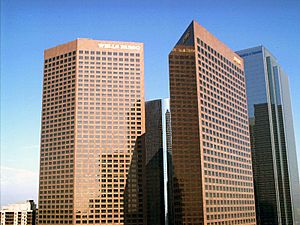
In 1955, Los Angeles city planners decided Bunker Hill needed a huge cleanup and rebuilding project. They wanted to remove old, run-down buildings. This project was called the Bunker Hill Urban Renewal Project, started in 1959.
The Los Angeles Police Department called the area a "high crime area." The health department also said it was a health risk. The city's Community Redevelopment Agency (CRA) won a court case against the residents of Bunker Hill. This meant many families had to move, and low-income residents were displaced. The CRA could then buy land to rebuild as they wanted. Although there were plans to save some historic buildings, most were torn down.
The redevelopment of Bunker Hill caused a lot of debate. The city cleared the land and sold it to private and public developers. This was part of the plan made by the CRA.
This project became the longest redevelopment project in Los Angeles history. Most of the tall buildings on Bunker Hill were built in the 1980s. New skyscrapers were finished almost every year. However, this slowed down in the 1990s after the 52-story Two California Plaza was completed.
Bunker Hill Today
Downtown Los Angeles has seen a big comeback. More businesses are moving in, and new homes are being built.
Affordable Homes
Today, developers are building many market-rate homes on Bunker Hill. However, Los Angeles has strict rules to make sure people of all income levels can live there. The city offers help and incentives to build homes that are affordable for people with lower incomes.
Jane Blumenfeld, a Principal City Planner, said, "We want to make it appealing to build downtown and get this extra affordable housing. We need enough lower-income housing so that in 20 years, Downtown doesn't become a neighborhood only for the rich."
For example, The Emerson apartment building has 271 units. Most are rented at market rates, but 55 units are offered at lower, subsidized rates. These are for tenants whose yearly income is less than 50% of the local average.
Cool Places to See
Library Steps
The Library Steps are a 60-foot wide (18 m) double stairway. They are a public art installation designed by Lawrence Halprin in 1989. These steps connect the main entrance of the Los Angeles Public Library with Hope Place and the Kechum-Downtown YMCA. A "stream" of river rocks flows down between the stairs. It starts from a pool around Robert Graham's 1992 sculpture Source Figure and ends at Fifth Street with a fountain.
Angels Flight Railway
The Angels Flight funicular railway was built in 1901. It originally connected Hill Street and Olive Street. In 1969, it was taken apart. Then, in 1996, it was rebuilt about 300 feet (91 m) further south. Now, it connects Hill Street with California Plaza.
Public Entertainment Spots
New public places have helped Bunker Hill become popular again. These include the Walt Disney Concert Hall and the Museum of Contemporary Art.
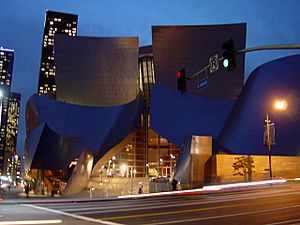
The Broad modern art museum opened next to the Disney Concert Hall on September 20, 2015.
Local Services
Emergency Help
The Los Angeles Police Department's Central Community Police Station serves Downtown Los Angeles, including Bunker Hill.
The Los Angeles Fire Department's Central Bureau also serves Downtown Los Angeles. Fire Station 3 (Civic Center/Bunker Hill) is located in the area.
Schools
The Los Angeles Unified School District provides education for the area.
Famous People from Bunker Hill
- Richard Crenna, actor
- John Fante, American novelist
- Leo Politi, Italian American artist and author
- Jack Webb, actor, producer, creator of Dragnet and Adam-12
- Otto J. Zahn, Los Angeles City Council member in the 1920s and pigeon racer
- Lynn "Buck" Compton, a World War II veteran and former judge.



